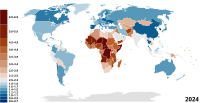
Photo from wikipedia
Abstract Introduction Fertility is one of the important vital components of population dynamics that determine the size and structure of the population in any region. Objective This study deals with… Click to show full abstract
Abstract Introduction Fertility is one of the important vital components of population dynamics that determine the size and structure of the population in any region. Objective This study deals with the socio-economic, demographic, and cultural determinants of fertility behavior in West Bengal. A total of 17,668 ever-married women (15–49 years) were utilized from National Family Health Survey (NFHS)-4, 2015–2016. Methods Simple percentage distribution, cross-tabulation, Pearson's χ2 test, and binary logistic regression analysis were carried out from the available NFHS-4 data for selected socio-economic, demographic, and cultural variables using Data Science software (STATA 12). Results The findings stated that there was significant variation in the likelihood of having high fertility with the selected covariates where it was found that the higher educated women [adjusted odds ratio (AOR): 0.0546; 95% CI: 0.0274–0.109], women who were married at the legal age at marriage i.e. 18 or above [AOR: 0.429; 95% CI: 0.387–0.476], the richest [AOR: 0.444; 95% CI: 0.3260.605] women, knowledge about family planning through full mass media exposure [AOR: 0.640; 95% CI: 0.484–0.845], resided in South Bengal region [AOR: 0.762; 95% CI: 0.683–0.850], household headship by the female [AOR: 0.734; 95% CI: 0.624–0.862] were less likely to have 3 or more children compared to the reference category. Women aged 35+ years [AOR: 31.63; 95% CI: 25.07–39.90], Muslim [AOR: 3.343; 95% CI: 2.887–3.871], and the women using contraception [AOR: 1.632; 95% CI: 1.456–1.830] were more likely to high fertility than the reference category in West Bengal. Conclusion There are various contributing covariates for the high fertility, among which are mother’s education, age at first marriage, current age, religion, social groups, wealth index, knowledge about family planning through mass media exposure, and household headship. All of these were strong covariates for CEB. More focus needs to be placed on the family planning programs, knowledge on contraception use, a wide range of family planning and health-related knowledge spread through mass media.
Journal Title: Children and Youth Services Review
Year Published: 2020
Link to full text (if available)
Share on Social Media: Sign Up to like & get
recommendations!